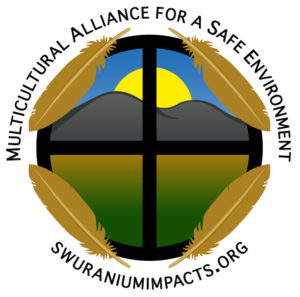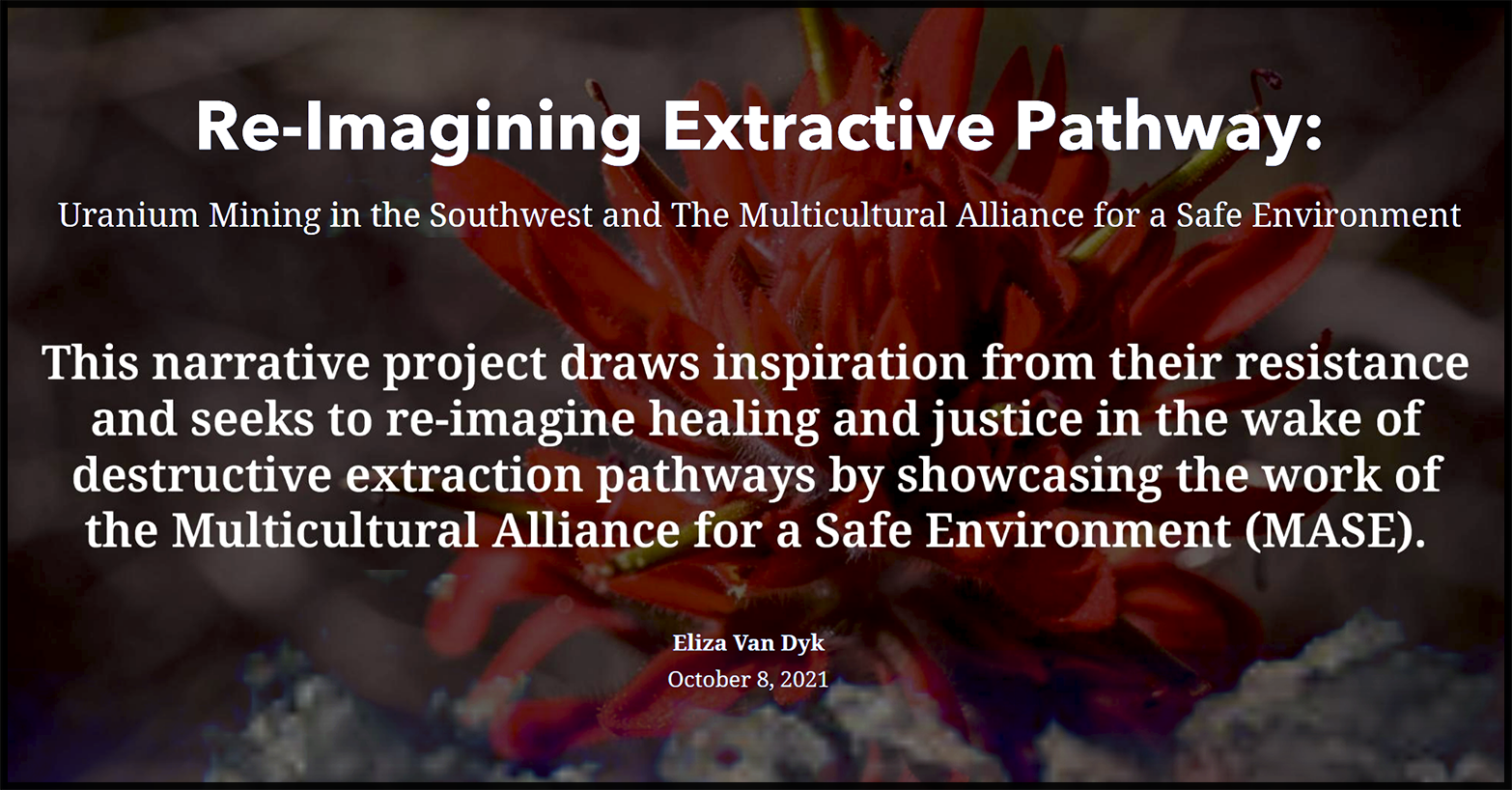Resisting the Nuclear Boom: A new wave of uranium mining threatens Indigenous communities in the Southwest

Resisting the Nuclear Boom: A new wave of uranium mining threatens Indigenous communities in the Southwest
By Klee Benally and Jessica Lee
March 31, 2010
GRAND CANYON, Ariz.—The American Southwest has again become ground zero in the debate about nuclear power.
Since December, miners have resumed crawling deep into the earth on the edge of the Grand Canyon to mine high-grade uranium ore at the Arizona 1 Mine, which had been closed since the late 1980s. Owned by the Canadian Denison Mines Corp., it is the first uranium mine to open in northern Arizona since nuclear power again became a popular idea in Washington within the last decade. The greater Grand Canyon area faces a possible explosion in the number of new uranium mines.
The price of uranium has rebounded in recent years due to a surge in reactor construction throughout the world and thanks to political support from the White House, starting with George W. Bush and reinforced by Barack Obama. The price has varied from $10 to $138 per pound since 2001, and is currently valued at $41.25 per pound.
More than 8,000 uranium mine claims have been filed in northern Arizona, an increase from 110 in 2003 — a rate seen across the West. The area’s sedimentary rock layer called breccia pipes, which exists up to 1,800 feet below the surface, is the most concentrated source of uranium known in the United States.
According to the Arizona Daily Sun, Denison plans on operating four days per week, extracting 335 tons of uranium ore per day. The hazardous ore will be hauled by truck more than 300 miles through towns and rural communities to the company’s White Mesa mill located near Blanding, Utah, where it will be processed into “yellowcake” (refined uranium ore to make uranium oxide) and then sold.
A coalition of environmental groups filed a lawsuit last November to stop the opening of the mine, alleging that the legally required documents were outdated and did not offer protections required by contemporary environmental laws. While the lawsuit is pending, the Bureau of Land Management and Arizona Department of Environmental Quality say the mine is properly authorized.
In response to growing concern about the pending mining boom in northern Arizona, U.S. Secretary of Interior Ken Salazar called for a “two-year time-out” last summer to allow federal agencies to complete a two-year environmental review before authorizing new mining claims within the one million acres on federal lands near the Grand Canyon. Existing claims, such as Denison’s mine, were exempt from the temporary moratorium.
Environmentalists and local Indigenous communities hope that after the review in February 2011, Salazar will make the area unavailable for new mining claims for the a maximum 20-year period allowed by the Interior Department. Meanwhile, the U.S. House of Representatives is considering the Grand Canyon Watersheds Protection Act (H.R. 644), legislation that would permanently protect the one million acres on federal land from new mining claims — creating a five-mile buffer zone of around Grand Canyon National Park.
However, Arizona’s Department of Mines and Mineral Resources Director Madan M. Singh is just one of many who oppose the ban. Testifying to a U.S. House subcommittee hearing in July 2009, he said that mining in the Grand Canyon region is necessary for worldwide power needs.
Citing U.S. Geological Survey estimates, Singh said that the ban would keep approximately 375 million pounds of yellowcake in the ground, which “at the present rate of generation, could replace all the power generated by coal plants in the United States for a decade. Another way to look at this: it is the equivalent of 13.3 billion barrels of oil. That is the total amount of recoverable oil in the Prudhoe Bay oilfield [in Alaska], the largest in the U.S. At a price of $50 per pound, this resource is worth $18.75 billion.”
 Under the anachronistic General Mining Act of 1872, created when pickaxes and shovels were used, mining companies can freely file claims on federal public lands. The law permits mining regardless of cultural impacts on Indigenous tribes. Additionally, no royalties have to be paid to the taxpayers in exchange for extracting riches from public lands.
Under the anachronistic General Mining Act of 1872, created when pickaxes and shovels were used, mining companies can freely file claims on federal public lands. The law permits mining regardless of cultural impacts on Indigenous tribes. Additionally, no royalties have to be paid to the taxpayers in exchange for extracting riches from public lands.
A SACRED CANYON
The Grand Canyon is the ancestral homeland to the Havasupai Nation. The Nation has battled uranium interests for decades and banned mining on their lands as early as 1991. However, their lands are surrounded largely by federal lands under the jurisdiction of the Bureau of Land Management, the National Park Service and the U.S. Forest Service — agencies that all have the power to authorize new mines.
The Colorado River is held sacred by more than 30 Indigenous nations. It emerges in the Rocky Mountains in north-central Colorado and winding 1,450 miles to the Gulf of California, the Colorado River and provides drinking water for up to 27 million people in seven states throughout the Southwest.
Drilling for the radioactive material in previous decades has been found to contaminate underground aquifers that drain into the Colorado River and sacred springs that have sustained Indigenous peoples in the region. Surface water can also flow into drill holes and mine shafts, poisoning underground water sources.
The 600 members of the Havasupai Tribe, who live at the bottom of the Grand Canyon, are concerned that future mining nearby could contaminate water sources and further desecrate sacred sites, including Red Butte, which is located three miles away from the closed Canyon Uranium Mine. Denison indicates that it is also interested in reopening the mine.
Some 300 people joined a rally at the South Rim of the Grand Canyon last August to support protecting the butte, known as Wii’i Gdwiisa, or “clenched fist mountain.”
“As the ‘guardians of the Grand Canyon,’ we strenuously object to mining for uranium here,” said Matthew Putesoy, vice chairman of the Havasupai Nation, to reporter Brenda Norrell. “It is a threat to the health of our environment and tribe, our tourism-based economy and our religion.”
“We’re fighting to save our sacred Red Butte and our only source of water, now that Denison Mines has begun uranium mining on the North Rim,” said Carletta Tilousi, a Havasupai Tribal Council member, in Indian Country Today March 26.
THE URANIUM LEGACY
Communities living in the arid southwest plateaus are still suffering from the consequences of the 20th-century uranium boom from the 1940s to late 1980s which fueled the nuclear weapons program and the first wave of nuclear power plants.
The tragic legacy is the contamination and illness that remains. Today, there are more than 2,000 abandoned uranium mines in the Southwest, and the U.S. government and private companies have done little or nothing to clean up contaminated sites and abandoned mines.
 Throughout the Diné (Navajo) Nation east of the Grand Canyon, families have been subject to decades of health effects due to past unsafe mining conditions and living near to mines and mills, in some cases even living in houses built from uranium tailings. Nearly four million tons of uranium ore were extracted from some 500 mines on Diné lands.
Throughout the Diné (Navajo) Nation east of the Grand Canyon, families have been subject to decades of health effects due to past unsafe mining conditions and living near to mines and mills, in some cases even living in houses built from uranium tailings. Nearly four million tons of uranium ore were extracted from some 500 mines on Diné lands.
At Rare Metals mine near Tuba City on the Diné Nation, a layer of soil and rock is the only material covering some 2.3 million tons of hazardous waste. A rock dam surrounds the radioactive waste to control runoff water that flows into nearby Moenkopi Wash.
The U.S. Environmental Protection Agency (EPA) has found well water to be undrinkable in at least 22 Diné communities. According to the EPA , “Approximately 30 percent of the Navajo population does not have access to a public drinking water system and may be using unregulated water sources with uranium contamination.” Uranium exposure is a known cause of cancers, organ damage, miscarriages and birth defects.
Flocks of sheep and other livestock still graze among radioactive tailing piles and ingest radioactive water.
According to the Diné Nation, every year up to 2.5 million gallons of uranium-contaminated water leaches out of the Shiprock Uranium Mill near Shiprock, N.M., into the San Juan River, a tributary to the Colorado River.
In July 1979 near the small Diné town of Church Rock, N.M., a dirt dam breached at the nearby uranium mine and processing site, releasing more than 1,100 tons of radioactive waste and nearly 100 million gallons of contaminated fluid into the Rio Puerco (which ultimately flows into the Colorado River) — marking the largest nuclear accident in U.S. history. More than 875,000 cubic yards of radioactive waste continue to contaminate the land.
In 2005, the Diné Nation government banned uranium mining and processing within its 27,000-square miles of land.
That’s why thousands of Diné residents near Church Rock were outraged in early March when the Federal 10th Circuit Court of Appeals voted to uphold a Nuclear Regulatory Commission license to allow Hydro Resources, Inc., to engage in uranium mining operations in the area, dangerously close to the aquifer that provides water for 15,000 Diné residents.
“Because the majority’s decision in this case will unnecessarily and unjustifiably compromise the health and safety of the people who currently live within and immediately downwind. … I must respectfully dissent,” wrote Judge Carlos F. Lucero in the minority opinion.
“The Navajo [Diné] communities … are demanding that they [the mining companies] stay off of Navajo lands,” wrote the New Mexico Environmental Law Center in a March 9 press release. “This court setback is even more devastating now that the nuclear industry ramps up its lobbying campaign to gain access to stimulus funds for construction of new nuclear plants. … It’s critical to look at the entire nuclear fuel chain.”
A PLACE FOR WASTE
Today, the United States has more than 75,000 metric tons of highly radioactive spent nuclear waste stored in concrete dams at nuclear power plants throughout the country. The waste increases at a rate of 2,000 tons per year.
In 1987, Congress initiated a controversial project to transport and ultimately store 135,000 metric tons of waste at Yucca Mountain, located about 100 miles northwest of Las Vegas, Nevada. The project would have involved shipping the radioactive waste via rails and highways starting in 2020.
In February 2009, Obama met his campaign promise to cut funding for the multi-billion dollar Yucca Mountain Nuclear Waste Repository project and asked the Nuclear Regulatory Commission to withdraw the license application.
Yucca Mountain is considered holy by the Paiute and Western Shoshone Nations. Western Shoshone lands, were never ceded to the U.S. government and have long been under attack by the military and nuclear industry. Between 1951 and 1992, more than 1,000 nuclear bombs were detonated above and below the surface at an area called the Nevada Test Site on Western Shoshone lands, making it one of the most bombed nations on earth. Communities around the test site faced exposure to radioactive fallout which has caused cancers, leukemia and other illnesses. The late Western Shoshone spiritual practitioner Corbin Harney helped initiate a grassroots effort to shut down the test site and abolish nuclear weapons.
In February, a new proposal for Yucca Mountain threatens to further desecrate the sacred mountain on Western Shoshone lands. Several Republican candidates for governor in Nevada have expressed support for using the area as an experimental “reprocessing” site, where radioactive waste would be reprocessed to extract additional fuel.
GRASSROOTS DIRECT ACTION
The Southwest also has a legacy of resistance to the onslaught of mining interests. In March 1988, more than 8,000 people converged for massive 10-day direct action to “reclaim” the Nevada Test Site, and nearly 3,000 people were arrested. Groups such as the Nevada Desert Experience and Shundahai Network continue their work to shut down the test site and resist the corporate and military nuclear industry.

Throughout the 1980s, a fierce movement of grassroots organizing and direct action against uranium mining near the Grand Canyon had taken shape, galvanized by the Havasupai, Hopi, Diné, Hualapai tribes and a Flagstaff group, Canyon Under Siege. Prayerful and strategic meetings were held once a year throughout the 1980s. In 1989, five individuals were charged for eco-actions including cutting powerlines to the Canyon Uranium Mine. Partly due to the resistance, but mainly because of a sharp drop in the price of uranium, companies like Dennison were forced to shut their mines down.
For seven years, Indigenous people from throughout the world have gathered to organize against the nuclear industry at the Southwest Indigenous Uranium Forum on the Acoma Nation near Mt. Taylor.
Mt. Taylor is located on U.S. Forrest Service-managed lands between Albuquerque and Gallup, N.M., and has also faced the threat of uranium mining. The mountain sits on one of the richest reservoirs of uranium ore in the country. It is considered holy by the Diné, Acoma, Laguna, Zuni and Hopi Nations. In June 2009, Indigenous nations and environmental groups unified to protect the mountain and through their efforts Mt. Taylor was given temporary protection as a Traditional Cultural Property.
At the 2006 Indigenous World Uranium Summit on the Diné Nation, community organizations such as Eastern Navajo Diné Against Uranium Mining joined participants from Australia, India, Africa, Pacific Islands and North America in issuing a declaration demanding “a worldwide ban on uranium mining, processing, enrichment, fuel use and weapons testing and deployment and nuclear waste dumping on native lands.”
OBAMA FUELS NUCLEAR RENAISSANCE
In January, the Obama administration FY2011 budget included a $54 billion dollar taxpayer loan guarantee for new nuclear reactor construction, three times what President George W. Bush promised in 2005.
“On an issue that affects our economy, our security and the future of the planet, we can’t keep on being mired in the same old stale debates between the left and the right, between environmentalists and entrepreneurs,”
Obama said about nuclear power in the State of the Union. He did not mention the impacts of mining and processing.
Currently, there are 104 nuclear reactors in operation in the United States that meet approximately 20 percent of the total U.S. electricity demand. In 2009, there were 17 uranium mines in operation producing more than 3.8 million tons of uranium oxide annually, according to U.S. Department of Energy statistics. Of the 50 former and present uranium milling sites across a dozen states, 24 have been abandoned and are now the responsibility of the Energy Department.
President Obama announced Feb. 16 that the Energy Department had approved $8.3 billion in federal loan guarantees for Southern Company and its partners to construct twin reactors in Georgia. Authorized by the Energy Policy Act of 2005, the loan guarantee programs are structured so that if the reactors are built and operate profitably, the borrowers pay the government a fee and repay the banks for the loan. However, if the borrowers default on the loan — which critics say is incredibly risky for the taxpayers — the federal government will repay the bank.
Since 2007, 17 companies or groups of companies have sought licenses from the Nuclear Regulatory Commission for 26 more reactors with plans to complete four by 2018 and up to eight by 2020. New reactors are estimated to cost more than $12 billion each. The last nuclear power plant in the U.S. was built in 1977.
“The demand for the fuel will expand in the future, especially with the emphasis on control of greenhouse gases,” Arizona Mines Department Director Singh said. “There are 436 reactors in operation in the world; another 433 are in development or on the drawing boards. It is evident that the demand for uranium will be strong in the coming years.”
Obama said, “Nuclear energy remains our largest source of fuel that produces no carbon emissions.”
“Obama’s support for nuclear energy is misguided and destructive federal policy,” said Stacy Hamburg of the Grand Canyon chapter of the Sierra Club. “The nuclear energy cycle is destructive from start to end … and is not the solution to climate change.”
According to The Washington Post March 22, a recent Gallup poll found that 62 percent of adults surveyed said they favored nuclear energy as one way to meet national electricity needs — the highest level of support reported by Gallup.
Although nuclear energy is being touted as a solution to the current U.S. energy crisis and global warming, those more closely affected by uranium mining, transportation, processing and dumping of waste recognize the true environmental costs.
“There are six licensed commercial nuclear reactors in New York,” Hamburg said. “It is critical for people in New York City, as well as nation- and world-wide, to understand how mining uranium, possibly destined for one of these six reactors, devastates indigenous communities throughout the Southwest.”
This article was adapted from an article written by Klee Benally. Jessica Lee revised the article and provided additional research with permission of the author. Klee Benally (Diné) is a collective member of Indigenous Action Media, on the Board of Directors of the Shundahai Network and is a musician with the group Blackfire.





